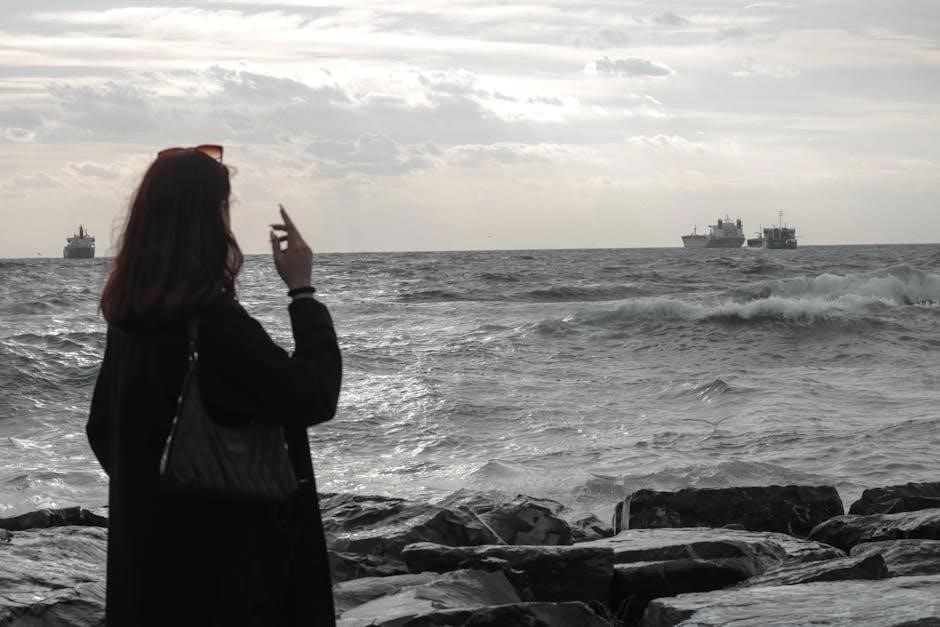The Viking Age (793–1066 AD) was a period of Norse seafarers’ raids, exploration, and cultural impact across Europe. Central to their success were longships, sleek, fast vessels enabling raids, trade, and navigation of rivers and seas, symbolizing Viking power and ingenuity.
Overview of the Viking Age
The Viking Age (793–1066 AD) was a transformative period marked by Norse seafarers’ raids, exploration, and cultural exchanges across Europe. It began with the infamous raid on Lindisfarne monastery in England and concluded with the Battle of Stamford Bridge in 1066. During this era, Vikings expanded their influence through settlements in the British Isles, Iceland, Greenland, and Eastern Europe, while also establishing trade routes along the Dnieper and Volga rivers.
Known for their seafaring prowess and longships, Vikings left a lasting impact on European history. Their raids disrupted existing political structures, while their settlements introduced Norse culture, language, and governance. The Viking Age also saw the rise of legendary figures and sagas, shaping the identity of Scandinavian peoples. This period remains a cornerstone of medieval history, highlighting the Vikings’ adaptability, courage, and enduring legacy.
Importance of Longships in Viking Culture
Longships were the cornerstone of Viking culture, serving as versatile vessels for warfare, trade, exploration, and daily life. Their sleek design allowed navigation of shallow waters and open seas, facilitating raids and the establishment of settlements across Europe. These ships symbolized Viking power and ingenuity, embodying their seafaring prowess and communal spirit.
Longships were not just tools of war but also symbols of status. Ornately carved dragon-headed ships, like the Gokstad and Oseberg vessels, were often used in ceremonial contexts, including burials of high-ranking chieftains. The construction of longships required exceptional craftsmanship, reflecting the advanced engineering skills of Viking shipbuilders. Their design influenced maritime architecture for centuries, leaving a lasting legacy in shipbuilding history. The longship’s role in Viking raids and explorations cemented its importance as a cultural icon, representing both the ferocity and the creativity of the Norse people.

Historical Background of Viking Longships
Viking longships emerged during the Viking Age (793–1066 AD), serving as vital tools for raids, exploration, and trade, and were renowned for their speed and maneuverability in various waters.
Origins and Early Development
The origins of Viking longships trace back to Scandinavia during the early Viking Age, evolving from earlier boat-building traditions. Constructed primarily from oak, these vessels were designed for speed, maneuverability, and versatility. The earliest longships were likely smaller and simpler, used for local raids and coastal trade. Over time, their design refined, incorporating overlapping planks and symmetrical ends, which enhanced their seaworthiness. These ships became iconic symbols of Viking culture, enabling their seafarers to traverse rivers and oceans alike. Their development marked the beginning of a maritime era that would shape European history, facilitating both conquest and exploration. The longship’s early evolution laid the foundation for its prominence in Viking society, as a tool for warfare, trade, and the establishment of new settlements.
Evolution of Longship Design
The design of Viking longships evolved significantly over the Viking Age, driven by the need for versatility in warfare, trade, and exploration. Early longships were smaller and more basic, with shallow drafts for navigating rivers and coastal waters. Over time, designs became more sophisticated, with longer and broader hulls, allowing for larger crews and greater cargo capacity. The introduction of sails alongside oars marked a key advancement, enabling longer voyages and reducing reliance on manual rowing. Shipbuilders also refined construction techniques, such as overlapping plank seams and symmetrical bow and stern designs, which improved seaworthiness. By the late Viking Age, specialized ships like the karvi and busse emerged, catering to specific roles in battle and trade. This gradual evolution underscored the Vikings’ mastery of naval engineering, adapting their vessels to meet the demands of their expanding ambitions.
Design and Construction of Longships
Viking longships were crafted with overlapping wooden planks secured by iron rivets, featuring a high bow and stern for navigating rough seas. Their flexible hulls, made from oak and other durable woods, allowed for speed and maneuverability, while shallow drafts enabled river travel.
Materials and Building Techniques
Viking longships were constructed primarily from oak and pine, chosen for their strength, flexibility, and availability. The hull was built first, with overlapping planks secured by iron rivets, creating a sturdy yet lightweight frame. Builders used tar to waterproof seams and animal hair for caulking. The ships featured a symmetrical design with high bow and stern, allowing for navigation in both shallow rivers and open seas. A large rectangular sail, often decorated with intricate patterns, provided propulsion, while rows of oars ensured maneuverability. The construction process, passed down through generations, exemplified Viking ingenuity and mastery of naval craftsmanship, enabling the creation of vessels that were both functional and visually striking.
Distinctive Features of Longships
Viking longships were renowned for their sleek, narrow hulls, which allowed for speed and agility in both shallow waters and open seas. Their streamlined design featured overlapping wooden planks, known as clinker construction, secured with iron rivets, providing durability and flexibility. The ships had a shallow draft, enabling them to navigate rivers and coastal waters with ease. A high bow and stern gave them a striking appearance and improved seaworthiness. Lightweight yet robust, longships could be carried over land, facilitating portage between waterways. Their versatility was enhanced by the combination of a square sail and rows of oars, allowing for both wind-powered and manual propulsion. Decorative elements, such as carved dragon or serpent heads on the prow, added symbolic and intimidating flair, reflecting their cultural and military significance.
Types of Viking Longships
Viking longships varied in size and purpose, with dragon-ships leading raids and others designed for trade or exploration, showcasing their versatility and adaptability in naval engagements and journeys.
Dragon-Ships and Their Significance
Dragon-ships, a prestigious type of Viking longship, were renowned for their large size, ornate dragon or serpent carvings, and capacity to carry numerous warriors. Often reserved for chieftains or kings, these vessels symbolized power, wealth, and status. Their sleek design and shallow draft allowed them to dominate both seas and rivers, making them formidable in raids and battles. The dragon-head prow, a distinctive feature, was believed to ward off evil spirits and strike fear into enemies. These ships were not only tools of warfare but also symbols of Norse culture and leadership, reflecting the Vikings’ mastery of naval architecture. The discovery of dragon-ships, such as the Gokstad and Oseberg vessels, has provided invaluable insights into their construction and historical significance.
Other Variations of Longships
Beyond the iconic dragon-ships, Viking longships included various specialized designs tailored for specific purposes. The karvi, for instance, was a smaller, more agile vessel, ideal for coastal raids and shallow waters. It featured fewer oars but maintained the sleek, streamlined profile of larger longships. The snekkja, or “snake,” was another variation, known for its narrow hull and speed, making it perfect for quick attacks and maneuverability in tight spaces. Larger ships like the busse and byrding were used for transportation and trade, emphasizing cargo capacity over warfare. These variations highlight the Vikings’ adaptability and ingenuity in shipbuilding, ensuring they had the right vessel for every mission, whether it was raiding, trading, or exploring new lands. This diversity in longship design underscored their dominance of the seas during the Viking Age.
Historical Significance of Longships
Viking longships were pivotal in shaping European history, enabling Norse exploration, raids, and trade. Their design influenced naval architecture, leaving a lasting legacy in maritime and cultural heritage;
Role in Viking Raids and Exploration
Viking longships were instrumental in their raids and exploration, facilitating swift attacks and long-distance voyages. Their shallow drafts allowed navigation of rivers, enabling inland raids, while their speed and maneuverability made them formidable in battles. These ships also played a crucial role in the Vikings’ expansion, establishing settlements in places like Iceland, Greenland, and Vinland. The longships’ versatility enabled both warfare and trade, showcasing the Vikings’ mastery of the sea. Their design and construction were key factors in the Vikings’ ability to dominate European waters for centuries, leaving a lasting impact on history and culture.
Impact on European History
Viking longships profoundly shaped European history by enabling Norse seafarers to explore, raid, and settle vast regions. Their shallow drafts allowed access to inland areas, facilitating the spread of Viking influence across the British Isles, France, and Eastern Europe. The Vikings established settlements, such as those in Normandy and the Danelaw, which became integral to local cultures and political structures. Their trade networks connected Europe, fostering economic growth and cultural exchange; The Viking legacy endures in language, place names, and legal systems, especially in regions like Iceland and the Faroe Islands. Their seafaring prowess also inspired later maritime advancements, leaving an indelible mark on Europe’s historical landscape.

Famous Viking Longships
The Gokstad Ship, measuring 30 meters, and the Oseberg Ship, with its intricate carvings, are renowned for their historical significance, craftsmanship, and role in Viking culture.
The Gokstad Ship
The Gokstad Ship, discovered in 1904, is one of the most well-preserved Viking ships found in Norway. Dating back to around 900 AD, it measures 23 meters in length and was built for both speed and maneuverability. Its oak hull was constructed using overlapping planks, secured with iron rivets, showcasing advanced Viking shipbuilding techniques. The ship featured 32 shields along its sides, indicating its use as a warship. It was found in a burial mound, where it had served as the final resting place for a Viking chieftain. The Gokstad Ship is a testament to Viking engineering and their seafaring prowess, providing invaluable insights into their culture and maritime achievements. Its discovery has significantly contributed to our understanding of Viking Age history and shipbuilding.
The Oseberg Ship
The Oseberg Ship, discovered in 1904 near Oslo, Norway, is one of the finest examples of Viking Age shipbuilding. Dating back to around 820 AD, it was found in a burial mound and is renowned for its intricate carvings and ornate designs. Unlike the Gokstad Ship, the Oseberg Ship was not primarily a warship but likely served ceremonial or ritual purposes. Its hull, constructed from oak, features elaborate dragon and floral patterns, showcasing Viking artistry. The ship was accompanied by sacrifices, including animals and possibly humans, reflecting its religious significance. Measuring 21.5 meters long, it was designed for speed and maneuverability, though its primary function appears to have been symbolic rather than practical. The Oseberg Ship provides a unique glimpse into Viking culture, blending maritime expertise with religious and artistic expression, making it a cornerstone of historical study.

Archaeological Discoveries
Archaeological discoveries of Viking longships have unveiled their sophisticated design and cultural significance, offering insights into Norse shipbuilding techniques and maritime traditions during the Viking Age.
Notable Finds and Their Importance
Archaeological discoveries of Viking longships have significantly advanced our understanding of Norse maritime culture. The Gokstad Ship, unearthed in 1880, is one of the most well-preserved examples, showcasing advanced shipbuilding techniques. The Oseberg Ship, discovered in 1904, revealed intricate wooden carvings and burial artifacts, highlighting the ceremonial use of longships; Similarly, the Skuldelev Ships, found in Denmark, demonstrate the variety of ship designs, from sleek warships to sturdy cargo vessels. These finds provide invaluable insights into Viking engineering, navigation, and societal structure. They also illustrate the central role of longships in Viking culture, serving as tools for exploration, warfare, and trade. Such discoveries underscore the enduring legacy of Viking seafaring expertise and its profound impact on European history.
The Skuldelev Ships
The Skuldelev Ships are a collection of Viking vessels discovered near the village of Skuldelev, Denmark, in 1962. These ships, dating back to the 11th century, were intentionally sunk in a fjord to block enemy naval advances. The discoveries include several types of ships, such as a cargo vessel, a warship, and a small boat, showcasing the diversity of Viking shipbuilding. The Skuldelev 2, a sleek warship, highlights the advanced design of Viking longships, with its lightweight construction and shallow draft, enabling speed and maneuverability. These finds have provided critical insights into Viking maritime technology and trade networks. The Skuldelev Ships are now preserved and displayed at the Viking Ship Museum in Roskilde, Denmark, offering a unique glimpse into the engineering and cultural values of the Viking Age.

Cultural and Symbolic Meaning
Viking longships symbolized strength, freedom, and the seafaring spirit of Norse culture. They played roles in mythology, rituals, and as status symbols, embodying Viking identity and pride.
Longships in Norse Mythology
Viking longships held profound cultural and symbolic meaning, often featured in Norse mythology as symbols of power and divine connection. They were associated with gods like Odin and Freyja, with myths describing their use in grand cosmic events. The most famous example is Ragnarök, where the giant serpent Jörmungandr is said to emerge from the sea, echoing the sea-faring spirit of the Vikings. Longships were also seen as status symbols, reflecting the wealth and prestige of their owners. Archaeological finds, such as the Gokstad and Oseberg ships, reveal intricate carvings and burial rituals, showcasing their role in Viking funerary practices. These vessels were believed to carry warriors to Valhalla, emphasizing their spiritual significance. Thus, longships were not just tools for warfare and exploration but also sacred vessels intertwined with Norse mythology and afterlife beliefs.
Symbolism in Modern Times
Viking longships continue to inspire modern culture, symbolizing strength, exploration, and cultural heritage. They are often used as national symbols in Scandinavia, appearing on coats of arms and in public art. Many companies and sports teams adopt longship imagery to evoke themes of adventure and resilience. In literature and film, longships represent epic journeys and the spirit of discovery. They also feature in educational programs, teaching historical significance and maritime innovation. Today, longships are celebrated as a connection to Viking history, embodying the values of seafaring prowess and communal effort. Their enduring appeal highlights their lasting impact on identity and storytelling, bridging the past with contemporary culture.
Legacy of Longships
Viking longships revolutionized maritime design, influencing modern shipbuilding with their sleek, efficient structures. Their cultural impact endures, symbolizing exploration, strength, and the enduring spirit of the Viking Age.
Influence on Modern Shipbuilding
Viking longships’ innovative designs have left a lasting impact on modern shipbuilding. Their lightweight, flexible hulls and streamlined shapes inspired advancements in naval architecture, emphasizing speed and maneuverability. The Vikings’ approach of constructing the hull first and then adding the frame contrasts with modern methods but highlights their ingenuity. Their use of overlapping planks caulked with tar and oakum influenced waterproofing techniques still studied today. The ability of longships to navigate both shallow rivers and open seas has inspired modern adaptations in boat design, particularly in recreational and historical vessels. Additionally, the cultural and historical significance of longships has led to their integration into maritime tourism and education, keeping their legacy alive in contemporary times.
Longships in Popular Culture
Viking longships have captivated modern audiences, appearing prominently in films, literature, and art. Their sleek design and historical significance make them a symbol of adventure and Norse heritage. Movies like How to Train Your Dragon and Viking feature longships as central elements, while TV series such as Vikings showcase their importance in raids and exploration. The Gokstad ship, one of the most well-preserved Viking vessels, has inspired replicas and museum exhibits worldwide. Longships also appear in video games, fostering a connection with younger audiences. Their cultural allure lies in their association with bravery, exploration, and the romanticized Viking lifestyle. This enduring fascination ensures that longships remain iconic symbols of history, inspiring creativity and curiosity across generations.

Resources and Further Reading
Explore detailed PDF guides on Viking longships, such as the Gokstad and Oseberg ships, and historical documents for insights into their design, history, and cultural significance.
PDF Guides on Viking Longships
PDF guides on Viking longships provide detailed insights into their construction, historical significance, and cultural impact. These guides often include architectural blueprints, historical accounts, and archaeological findings. The Gokstad Ship, measuring 23 meters long, and the Oseberg Ship, known for its intricate carvings, are frequently featured. Additionally, PDF resources explore the Skuldelev Ships, a collection of vessels discovered in Denmark, showcasing variations in design and purpose. These guides are invaluable for understanding the engineering prowess of Viking shipbuilders, who used overlapping wooden planks and iron rivets to create durable, seaworthy vessels. Many PDFs also delve into the historical context of longships, their role in raids, and their evolution over time. They serve as a comprehensive resource for historians, enthusiasts, and educators seeking to explore the fascinating world of Viking longships in depth.
Recommended Historical Documents
Historical documents provide invaluable insights into the Viking Age and longships. The Gokstad Ship, discovered in 1904, had 32 shields, while the Oseberg Ship is renowned for its intricate carvings. The Skuldelev Ships, found in Denmark, reveal variations in design and purpose. These documents highlight the engineering skills of Viking shipbuilders, who used overlapping planks and iron rivets for durability. They also explore the historical context of longships in raids and trade. PDF guides like “The Viking Longship” by A.W. Brøgger offer detailed analyses of these vessels. Such documents are essential for understanding the cultural and historical significance of longships, making them a must-read for anyone interested in Viking history and maritime archaeology. These resources are readily available as PDFs, offering a wealth of knowledge for enthusiasts and scholars alike.
The Viking longships were iconic vessels that shaped history, enabling exploration, raids, and cultural exchanges. Their enduring legacy reflects the ingenuity and seafaring prowess of the Viking Age, leaving a lasting impact on maritime history and culture.
The Viking Age (793–1066 AD) was defined by Norse seafarers’ raids, exploration, and cultural exchanges. Longships, their iconic vessels, were central to their success, enabling swift movement across seas and rivers. Constructed from oak, these ships featured overlapping planks and a flexible hull, allowing for speed and maneuverability. They were used for warfare, trade, and exploration, symbolizing Viking power and ingenuity. Longships like the Gokstad and Oseberg ships showcased advanced craftsmanship, with intricate designs and burial practices. Archaeological discoveries, such as the Skuldelev ships, have provided insights into their construction and historical significance. These vessels not only shaped Viking culture but also left a lasting impact on maritime history and European development.
Final Thoughts on the Importance of Longships
Viking longships were indispensable to the Viking Age, embodying their seafaring prowess and cultural identity. Their innovative design, with overlapping oak planks and a flexible hull, allowed for unparalleled speed and maneuverability, making them ideal for raids, trade, and exploration. Beyond their practical use, longships held deep symbolic meaning, representing Viking strength, unity, and their connection to the sea. Archaeological discoveries, such as the Gokstad and Oseberg ships, have revealed the sophistication of their craftsmanship and the cultural significance of these vessels. Longships not only shaped Norse society but also left a lasting legacy in European history, influencing maritime trade, exploration, and the spread of ideas. Their enduring appeal in modern culture underscores their historical importance and the fascination they continue to inspire.
